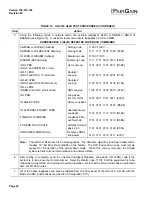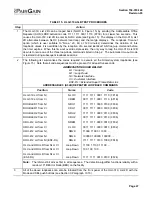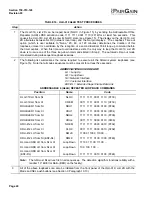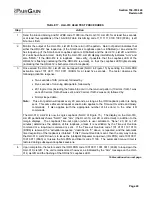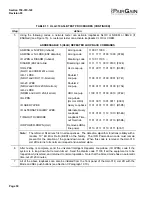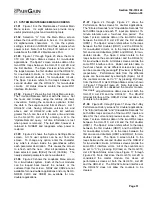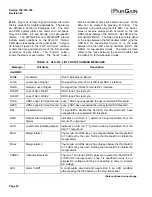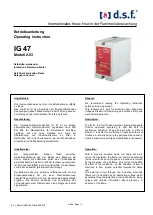
Section 150-319-124
Revision 03
Page 37
C. APPLICATIONS USING HIGAIN DOUBLERS
(HDU-451)
17. DOUBLER DEPLOYMENT RULES
17.01
For doubler applications, one or two doublers
may be used in the HDSL loops between the HLU-
319, List 2D and the HRU-412. When using two
doublers in a HDSL loop, the HRU-412 must be locally
powered. The HLU-319, List 2D can be used with the
low power HDU-451, List 3, List 4, and the HDU-
439/437 List 1 doubler units over the entire CSA
range in all 3 spans.
17.02
Use of the HLU-319, List 2D with the higher
power HDU-451, List 1 or List 2 doubler is restricted
per the following deployment rules:
1. If Span 1’s loop resistance is known, then
the maximum loop resistance of Span 2 is
the smaller of either 800 ohms or the
following calculated value:
Maximum Span 2 Loop Resistance =
[2600 - 4 (Span 1 Loop Resistance)]
ohms
For example, if Span 1 Loop Resistance =
550 ohms, then Span 2 Loop Resistance
must be no more than 400 ohms. If Span
1 Loop Resistance = 400 ohms, then Span
2 Loop Resistance must be no more than
800 ohms.
2. If Span 2’s loop resistance is known, then
the maximum loop resistance of Span 1 is
calculated as follows:
Maximum Span 1 Loop Resistance =
[650 - (Span 2 Loop Resistance/4)]
ohms
For example, if Span 2 Loop Resistance =
700 ohms, then Span 1 Loop Resistance
must be no more than 475 ohms.
Note: The Span Resistance formulas in
Rules 1 and 2 above illustrate that
Span 1’s resistance has four times the
effect on the total circuit’s range than
does Span 2’s resistance. In other
words, if Span 1 can be reduced by 50
ohms, Span 2 can be increased by 200
ohms. So, always minimize the length
of Span 1.
3. Only HRU-412 units with list numbers
greater than 5 can be used. Thus, while
Lists 1, 2, 3, 3A, 4, and 5 can not be used,
Lists 6, 7, and greater can.
4. The HRU-412 CPE current option must be
set to 0 mA. Its 60 mA CPE current switch
must be set to 0 mA, or, its card edge pins
must be strapped for 0 mA in the enclosure
that provides these strapping options.
5. In two-doubler applications, the first
doubler (the one nearest the HLU) can be
a List 1 or List 2. The second doubler,
however, must be a List 3 unit.
6. In general, to optimize doubler
performance, minimize the length of Span
1 and maximize the length of Span 3.
18. POWER CONSUMPTION
18.01
The maximum current drain is the current
drawn from the shelf power supply when it is at
minimum voltage (-42.5 Vdc) under a worst case
application. The worst case application for the HLU-
319, List 2D occurs on a loop with one HDU-451
doubler, four 9000-foot #26 AWG spans, and an HRU-
412 that is providing 60 mA of CPE current. Under
these conditions, the HLU-319, List 2D current drain
from the -42.5 Vdc battery is 0.6 A. CO current and
other related power parameters for various doubler
applications are listed in Table 11.
18.02
The maximum HLU-319, List 2D power
dissipation is the power that is converted into heat
within the unit. It contributes to the total heat
generated and is used to determine the maximum
number of shelves per bay that do not exceed the
maximum power dissipation density in Watts/sq. ft.
18.03
In CO locations, the maximum power
dissipation for open-faced, natural convection cooled
mountings is 120 Watts/sq. ft., as stated in NEBS
standard TR-NWT-000063 Section 4.2.3. The
footprint of a 28-slot HLU-319 shelf is 7.024 sq. ft.
Thus, the maximum allowable dissipation is 840 W, at
9 Watts maximum per slot. This limits the number of
HLU-319, List 2D units per bay to 94.
18.04
The thermal loading limitations imposed when
using the HLU-319, List 2D in a Controlled
Environmental Vaults (CEV) or other enclosures are
determined by applying the HLU-319, List 2D power
parameters to the manufacturer requirements for each
specific housing.
























